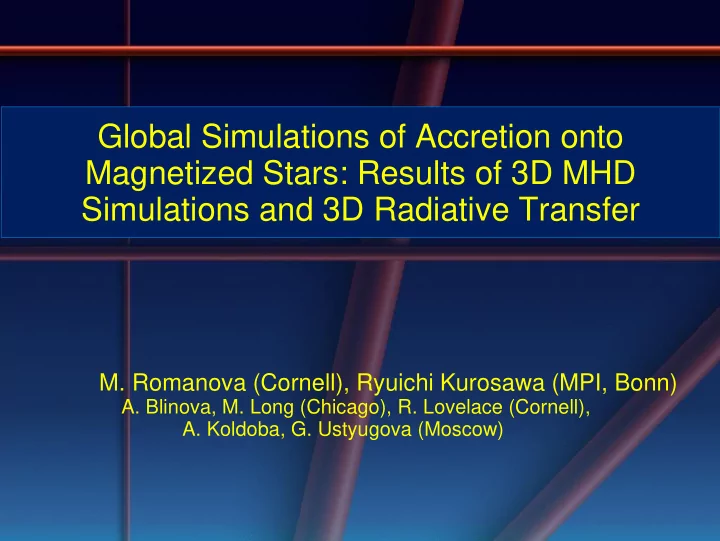

Global Simulations of Accretion onto Magnetized Stars: Results of 3D MHD Simulations and 3D Radiative Transfer M. Romanova (Cornell), Ryuichi Kurosawa (MPI, Bonn) A. Blinova, M. Long (Chicago), R. Lovelace (Cornell), A. Koldoba, G. Ustyugova (Moscow)
Young, classical T Tauri Stars (CTTS) • Young stars, like our Sun in the past, 1-10 Myr • Magnetic field is 1000 times larger than the Sun’s field • The magnetic field opens a gap in the disk • Matter falls to polar regions forming the hot spots • Observational properties – disk-magnetosphere interaction
Numerical Model • 3D, 2 nd order Godunov-type ( Koldoba et al. 2002 ) • Cubed sphere grid, 61x61x140 Disk: a - disk ( a vis =0.02) • • Initial equilibrium, disk and corona • Dipole or more complex field Cubed Sphere Grid 3D simulations 3
Ideal MHD Equations: • Equations are written in the coordinate system rotating with a star • Splitting of the field: B = B 0 + B 1 ( Tanaka 1994 ) Corotating frame No shocks Ideal Stress tensor Adiabatic
Stable and Unstable Regimes • Stable : accretion in two ordered funnel streams • Unstable : matter accretes in chaotic tongues, Rayleigh- Taylor instability Kulkarni & Romanova 2008; R., Kulkarni & Lovelace 2008; Arons & Lea (1976)
Stable and Unstable Regimes
An Example of Unstable Accretion
What determines the regime? Always unstable (Chandrasekhar 1960) B z Less dense Dense g eff Shear in the disk g eff = g – W 2 r acts to suppress the instability Spruit et al. 1995; Lubow & Spruit 1993; Kaisig, Tajima, Lovelace 1992
Observations: Variability of T Tauri stars Periodic Non-Periodic PERIODIC: Spots + Stellar Rotation APERIODIC: Origin ? Stars have strong B-field. Period ? ● CoRoT observations of 83 CTTSs in NGC 2264, ● Alencar, Bouvier et al. (2010) ● About 40% of CTTSs show irregular light curves!
Testing the Magnetospheric Accretion Project our MHD data to the TORUS grid (velocity, density) Adaptive Mesh refinement of TORUS code Spectrum in H and He lines and images in lines Kurosawa, Romanova, Harries 2008, 2011; TORUS -Tim Harries
Radiative Transfer Code TORUS Non-LTE population of H and He atoms obtained by using the method described in Klein & Castor (1978) – originally developed for O star wind model. Main assumptions: 1.Core-Halo approach: Continuum radiation is dominated by the “core”, but not by accretion flows. 2.Sobolev approximation: assumes the velocity gradient is large in the wind/accretion. – e.g. the mean intensity ( J ij ) is expressed in terms of “escape probabilities ( β ij , β c,ij ) (e.g. Castor 1970)
Mass-Accretion Rate Almost constant Smooth Variable Irregular ● Took 25 slices per rotation, 3 periods of rotation ● Use the density and velocity fields and compute the corresponding line profiles and continuum flux ● Model includes the effect of hot spot radiation (variable size and shapes)
Simulations: Light Curves ● Unstable case: irregular light curves due to stochastic formations of “tongues” and hotspots. Stable Unstable
Lightcurve: CTTS TW Hya Unstable Model Observation Flux at 410.1 nm (H δ ) Stochastic Light curve of TW Hya ~3 Rotations ● Left : MOST's observation – lightcurve by Rucinski et al (2008) ● Model shows a similar number of random peaks per stellar rotation. ● The amplitudes of variations are also similar. ● Need more analysis - - SPECTRUM ! Kurosawa & Romanova 2013
Time-Evolution of H δ line profile Stable regime Periodic redshifted absorption Kurosawa & Romanova 2013
Time-Evolution of H δ line profile Unstable regime Redshifted absorption is seen more frequently Kurosawa & Romanova 2013
Persistent Redshifted Absorption Unstable Stable Variable but persistent redshifted Redshifted absorption component absorption component appears once per rotation.
Comparison with Observations: Line Variability TW Hya Observation: EW of Ca II Unstable Model: H δ Donati et al. (2011) Significant intrinsic variability (stochastic) as in our model. Non-Periodic Line Variability: ● TW Hya (Donati et al. 2011), DR Tau (Alencar et al. 2001) etc. PREDICTION : Variable spectra, redshifted absorption – signs of accretion through R-T INSTABILITY. There are candidates CTTSs.
Magnetic Field in CTTSs is Complex V 2129 Oph SU Auriga Donati, Jardine, Gregory et al., 2007, 2010 19
Accretion onto Stars with Complex Fields B=B dip +B quad +B oct + …
Magnetic field of V2129 Oph & BP Tau V2129 oph BP Tau Dipole: 0.35 kG (0.9 kG) Dipole: 1.2 kG Octupole: 1.2 kG (2.1 kG) Octupole: 1.6 kG Donati, Jardine, Gregory et al., 2007-2013 21
Aligned Quadrupole and Dipole Fields Dipole + Quadrupole 22
Octupole Field Hot spots – 2 rings Long, Romanova, Lamb, Kulkarni, Donati 2009 23
Initial field of V2129 Oph in our Model M=1.35 M_Sun R=2.4 R_Sun P=6.35 days Rcor=6.8 R_star M_dot=6.3 10 10 Donati et al., 2007 24
Application of model to T Tau star V2129 Oph Initial field 3D simulations Romanova, Long, Lamb, Kulkarni, Donati 2009 25
Application of model to T Tau star V2129 Oph Density map and B field lines on X-Z plane Dipole and octupole components Calculated 3D MHD flow Calculate spectrum in Hydrogen lines using 3D code TORUS 26 Compared spectrum with observations
H β Profiles and Images Model: Flux map in H β 0.25 0.75 0.50 0.00 Model: H β Profiles 0.25 0.50 0.75 0.00 Observation: Alencar et al. (2011) Good agreement between 3D MHD + 3D RT simulations and observations This is a new tool for testing models and confronting them with observations Page 27
Conclusions ● Developed 3D MHD + 3D radiative transfer tool for analysis of young stars ● Can compare photometric and spectral variations in observed and modeled stars, can validate MHD models ● Can predict new phenomena such as accretion through instabilities – persistent redshifted absorption
Recommend
More recommend